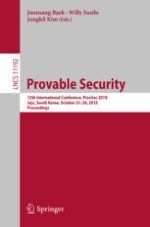2018 | Book
Provable Security
12th International Conference, ProvSec 2018, Jeju, South Korea, October 25-28, 2018, Proceedings
Editors: Joonsang Baek, Willy Susilo, Jongkil Kim
Publisher: Springer International Publishing
Book Series : Lecture Notes in Computer Science
